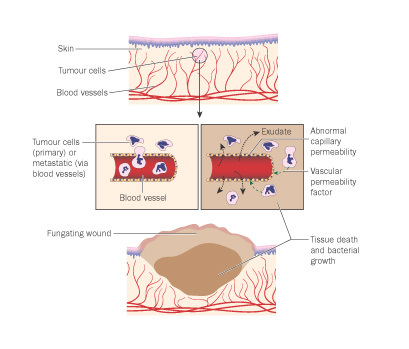Fungating Wounds
What are Fungating Wounds?
Fungating lesions are known as ‘masses’ or ‘ulcerative lesions’ and are a result of cancerous cells infiltrating epithelial tissue1.

Fungating Wound management
The management of patients with a fungating wound is focused essentially upon symptom control and appropriate psychosocial support. They pose a problem for both patients and healthcare professionals as they signify progressive and life threatening disease and affect quality of life by causing unpleasant and difficult to manage symptoms2.
Symptoms of Fungating Wounds
The main presenting symptoms for a fungating wound are3;
- Pain
- Malodour
- Heavy exudate
- Peri-wound excoriation
- Capillary bleeding
- Local Infection
Assessing Fungating Wounds
Accurate assessment is critical to identify the symptoms and how these are impacting upon the patient and self reporting by the patient may be considered an effective method.
It is critically important for health care professionals to understand the synergies between the symptoms. Infection caused by the synergy of aerobic and anaerobic bacteria at the wound bed gives rise to the malodours4. These malodours lead to grave psychological problems for the individual: embarrassment, loss of self-respect, guilt, anger, denial, fears of the stigma associated with cancer and social isolation5. Due to the profound impact odour can have on the patient, it is important for an odour assessment to be completed so this can be addressed and treated.
Dressings should be selected which manage the patient’s symptoms and:
- Reduce / eliminate wound malodour
- Manage and treat wound infection
- Manage wound exudate and protect the peri-wound area
- Provide haemostasis
- Manage the tissue types at the wound bed
- Facilitate atraumatic dressing changes
- Improve quality of life / reduce social isolation
- Are comfortable and aesthetically pleasing for the patient
Activated charcoal dressings are most commonly used to eliminate the malodour such as CliniSorb which provides complete odour control through the charcoal layer absorbing any bacteria and trapping it within the dressing.
References:
- Foltz, A.T. (1980) Nursing care of ulcerating metastatic lesions. Oncology Nursing Forum 7: 2, 8 – 13
- Grocott, P. (1995) The palliative management of fungating malignant wounds. Journal of Wound Care 4: 5, 240 – 242
- Charles-Edwards, A. (1983) The Nursing Care of the Dying Patient. Beaconsfield Ltd.
- Hampson, J.P. (1996) The use of metronidazole in the treatment of malodorous wounds. Journal of Wound Care
- 9, 421 – 426 5 Neal, K. (1991) Treating fungating lesions. Nursing Times 87: 23, 84 – 86
Caveat: The information given is a guide only and should not replace clinical judgement.
